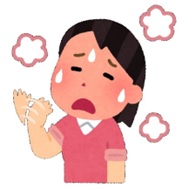2024.05.01
Risk2: Heat & Cold
Hypothermia
Hypothermia is a condition in which the body temperature (core body temperature) of vital organs such as the brain and heart falls below 35°C. If 32-35°C it's mild, if 28-32°C it's moderate, if 20-28°C it's severe.
What happens if you get heat stroke?
If your body temperature drops due to exposure to wind for a long time while being wet (whether by rain or sweat) hypothermia may develop even in the middle of summer or at low mountain elevation. You become more prone to hypothermia when your body's heat difusion is disrupted by stress, etc. to the autonomic nerves which contracts the blood vessels.
What happens if you get hypothermia?

<Main symptoms>
- Whole body shivering, chills, drowsiness, staggered walking
↓
- Loss of consciousness, cessation of shaking, inability to stand
↓
- Coma, cardiopulmonary arrest
Looking at the above, you may have an image that hypothermia progresses gradually over a long period of time. Actually, in a mountain environment, consciousness disturbance occurs at an accelerated rate. The scary part is that when you first feel the chills and shivering, it goes quickly from there.
<Preventive measures>
1) Keep your body warm and dry
- Wear quick-drying underwear
- Wear warm clothing such as fleece
(Layered clothing for easy adjustment)
- Windproof and waterproof rainwear
2) Frequent intake of high-calorie foods
- Chocolate and nuts
- Hot sweet drinks
>> For walking tips and what to do if you get hypothermia, check out "While Climbing"
Heat stroke
At Mt. Fuji, one tends to notice only "altitude sickness" and "hypothermia" but there is also the risk of "heat stroke". In particular, there are no shade trees that can block the sun on the trails of Mt. Fuji. Since the back of your head is often exposed to direct sunlight for a long time, please be careful.
What happens if you get heat stroke?

<Main symptoms>
- Dizziness/lightheadedness, profuse sweating, muscle cramps
↓
- Headache, nausea, fatigue, poor concentration/judgment
↓
- Impaired consciousness, convulsion/ seizure, body becomes hot, staggered walking
<Preventive measures>
- Wear a wide-brimmed hat that also covers the back of the head.
(with a fastenable chin strap to prevent from blowing away by the wind)
- Dress cool.
(Especially when descending mountains, there are cases where people get heatstroke because they don't adjust their clothes or drink enough water.)
- If outdoors, remove your mask as appropriate.
- Frequent hydration (sports drinks and oral rehydration solutions are effective)
(1.2 liters per day is a guideline. Especially for the Yoshida/Subashiri/Gotemba trails, make sure you have enough water for the descent.)
>> For walking tips and what to do if you get heat stroke, check out "While Climbing"
<Brief memo>

Generally, the temperature drops by 0.6°C (1.1°F) for every 100m in altitude. Also, as the wind speed increases by 1 m/s (2.2 mph), the wind chill temperature drops by 1.0°C (1.8°F). Even though the temperature is warm at the foot of the mountain, it can be much colder at the summit.
The temperature will drop depending on the weather and the time of day, so dress in layers to regulate your body temperature.


